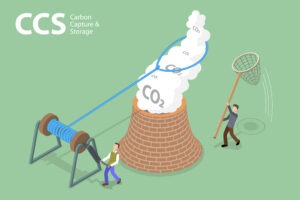
Carbon capture and sequestration is the latest rage, but is it worth the hype? In Chasing Squirrels in the Energy Transition, Environmental Law, Vol. 52 No.2 237 (2022) Heather Payne takes a close and timely look at the track record and issues surrounding carbon capture and sequestration (CCS). As CO2 levels continue to rise and global warming brings new and worsening disruptions the desire to reduce CO2 levels has brought forth various responses. Those wishing to continue to produce CO2 as part of the modern economy have sought solutions which might allow continued burning of fossil fuels, in particular coal fired electricity generation. CCS, which is premised upon the capture of CO2 and its permanent sequestration from the atmosphere has been a prominent and now perennial solution in search of viability.
The Government Accountability Office recently released a critical report detailing the DOE’s management of $1.1 billion in CCS projects funded by the Federal government. The themes echo Payne’s hard look at the real costs and uncertainty with CCS. A provision in the Energy Act of 2020 directed the GAO to review the Department of Energy’s (DOE) practices, successes, failures, and any recommendations for improvements in executing CCS demonstration projects. Between 2009 to 2022, the DOE provided $684 million to eight coal projects. Every project went over budget and exceeded timelines. Only one project went into operation, and even that project eventually shut down because it was not economically viable. In summary, none of the federally funded coal fired electric generation plants succeeded in demonstrating the potential for a viable application of CCS. The report documented a pattern of hope overriding reason. Projects exceeded deadlines, failed to demonstrate viability, and went over budget. Nevertheless, DOE bypassed cost controls at the direction of its senior leadership in order to provide additional time to meet key milestones. Ultimately, DOE spent nearly $472 million on projects that were never built, which was $300 million more than what they had originally planned to spend up to that point. The consistent lack of project viability is one reason that private funders have been reluctant to fund these fanciful projects. The GAO recommended stronger oversight and accountability on CCS projects. “Absent such a mechanism, DOE may be at risk of expending significant funds on CCS demonstration projects with little likelihood of success.”
The process of carbon capture in the application most often attempted by industry to date, fossil fuel generated electricity, demonstrate that the comparative costs per kilowatt hour of renewables versus carbon capture even with government subsidy are not sustainable in a free market. Setting aside the economics of carbon capture from stationary sources, Payne addresses the real problem, permanent sequestration of carbon that is successfully captured. Short term storage solves nothing when it comes to climate change.
The challenges of permanent sequestration involve both technological shortfalls as well as questions of liability regimes for management of a permanent repository. Beginning with technical challenges, current technology is capable of measuring carbon sequestration success (finding leakage of stored carbon) from underground storage accurately to within plus or minus 5-30 percent. As has been demonstrated to date, oil and gas production today fails to capture or control methane for which there is a market. The only market for quantities of CO2 is for enhanced recovery of more fossil fuels. Indeed, that has been the use to which carbon capture has been used to date and the purpose behind the DOE funded projects analyzed in the GAO report. Enhanced recovery operations do not function as nor are not they intended to provide permanent carbon sequestration. Rather the present economics of enhanced recovery depend on CO2 as a commodity rather than as a problem in need of a permanent solution.
Payne identifies three major non-legal challenges. Site selection of an underground formation will require seismic mapping and detailed survey of formations for what will, at best, amount to informed predictions of appropriateness of formations for long term carbon storage. Measurement and verification in both the storage and transport of CO2, are highly problematic issues for something that must result in permanent sequestration. Infrastructure has the added challenge of the highly corrosive properties of CO2 in the presence of even small amounts of water.
The risks associated with CCS beyond failure to address climate change include the risk of death for those exposed to high concentrations such as are released from infrastructure failures, water quality and quantity and land use from both a loss of productivity and continued effects on populations located in industrial areas.
In balancing the costs and risks of CCS with the yet unproven benefits of the technology the question arises under what type of legal regime should such a technology arise. This question remains whether CCS is freed of the market constraints affecting other alternatives through tax policy and government funding. What liability paradigm makes sense for development of CCS? Common law remedies such as trespass and negligence are inadequate if for no other reason than the nature of the most fundamental harm which is failure to meaningfully reduce CO2. Because the failure to provide permanent sequestration is both a problem in perpetuity and at present impossible to prove except under the most egregious circumstances, both regulation and strict liability are called for. Existing regulatory authority such as the Underground Injection Permit program for construction, operation, permitting, and closure of injection wells designed to protect drinking water supplies is applicable through a new class of wells (Class VI) specifically for CCS. 40 C.F.R. §§16.81-146.95 (2020). Even assuming early success and adequate bonding at the time of permitting, long term liability would transfer to the federal government upon closure of the injection well. By the time leakage of CO2 were discovered the original project operators and proponents are no longer in the picture. Liability caps such as Price – Anderson for the nuclear generation industry leaves us with the same problem, one, we still have not resolved for spent nuclear fuel.
Chasing Squirrels makes a strong case for recognition of what is driving CCS. Continued production of CO2 with the false, but lucrative promise, that the problem of climate change can be solved by putting it where the sun does not shine.
 Tom Mitchell, Wallace Stegner Fellow. Tom practiced Natural Resource and Environmental Law for most of his 40 years as a practicing attorney. He also taught Oil and Gas Law at the S.J. Quinney College of Law for 15 years. He joined the Law and Policy Program in 2021.
Tom Mitchell, Wallace Stegner Fellow. Tom practiced Natural Resource and Environmental Law for most of his 40 years as a practicing attorney. He also taught Oil and Gas Law at the S.J. Quinney College of Law for 15 years. He joined the Law and Policy Program in 2021.
